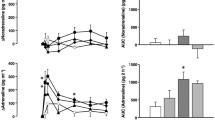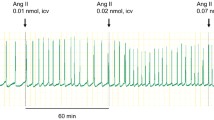Abstract
Agmatine has been identified as a “clonidine-displacing substance” in extracts from bovine brain. We studied its effect on cardiovascular regulation and the role played in this effect by α2-adrenoceptors.
In conscious rabbits, agmatine 10 μg kg−1 injected intracisternally (i.e.) caused no change, whereas agmatine 30, 100 and 300 μg kg−1 i.e. increased renal sympathetic nerve firing, the plasma concentration of noradrenaline and adrenaline and arterial blood pressure. Heart rate tended to be decreased. Yohimbine 1.5 μg kg−1 i.e. caused no change, whereas yohimbine 5, 15 and 50 μg kg−1 increased renal sympathetic nerve activity, the plasma concentration of noradrenaline and adrenaline, blood pressure and heart rate. In rabbit brain cortex slices preincubated with [3H]-noradrenaline, agmatine 1 to 100 μM did not modify the electrically evoked overflow of tritium (either 4 pulses at 100 Hz or 36 pulses at 3 Hz). The evoked overflow was reduced by 5-bromo-6-(2-imidazolin-2-ylamino)quinoxaline (UK 14304) 0.03 to 30 nM (4 pulses at 100 Hz), and this inhibition was not affected by agmatine 10 and 100 μM. Agmatine did not change the basal efflux of tritium.
The results show that agmatine, like yohimbine, causes central sympathoexcitation when given i.e., but agmatine differs from yohimbine in that it does not increase heart rate. Agmatine acts neither as an agonist nor as an antagonist at the α2-autoreceptors in rabbit brain cortex. α2-Adrenoceptors, therefore, are probably not involved in its cardiovascular effects. An action at imidazoline receptors in the medulla oblongata or some other hitherto unknown mechanism may be responsible for the sympathoexcitation.
Similar content being viewed by others
References
Atlas D (1991) Clonidine-displacing substance (CDS) and its putative imidazoline receptor. Biochem Pharmacol 41:1541–1549
Atlas D, Burstein Y (1984a) Isolation and partial purification of a clonidine-displacing endogenous brain substance. Eur J Biochem 144:287–293
Atlas D, Burstein Y (1984b) Isolation of an endogenous clonidine-displacing substance from rat brain. FEBS Lett 170:387–390
Bousquet P, Feldman J, Schwartz J (1984) Central cardiovascular effects of alpha adrenergic drugs: differences between catecholamines and imidazolines. J Pharmacol Exp Ther 230: 232–236
Bousquet P, Feldman J, Atlas D (1986) An endogenous, non-catecholamine clonidine antagonist increases mean arterial blood pressure. Eur J Pharmacol 124:167–170
Bousquet P, Feldman J, Atlas D (1987) Central cardiovascular effects of a noncatecholamine endogenous ligand for clonidine receptors. J Cardiovasc Pharmacol 10 [suppl 12]:S167-S171
Bousquet P, Bricca G, Dontenwill M, Feldman J, Greney H, Belcourt A, Stutzmann J, Tibirica E (1992) From the α2-adrenoceptors to the imidazoline preferring receptors. Fundam Clin Pharmacol 6 [suppl 1]:15s–21s
Bylund DB (1994) Pharmacological characteristics of α2-adrenergic receptors. II International Symposium on Imidazoline Receptors: Abstract S1
Diamant S, Atlas D (1986) An endogenous brain substance, CDS (clonidine-dispacing-substance), inhibits the twitch response of rat vas deferens. Biochem Biophys Res Commun 134:184–190
Diamant S, Eldor A, Atlas D (1987) A low molecular weight brain substance interacts, similarly to clonidine, with α2-adrenoceptors of human platelets. Eur J Pharmacol 144:247–255
Ernsberger P, Meeley MP, Reis DJ (1988) An endogenous substance with clonidine-like properties: selective binding to imidazole sites in the ventrolateral medulla. Brain Res 441:309–318
Ernsberger P, Elliott HL, Weimann HJ, Raap A, Haxhiu MA, Hofferber E, Löw-Kröger A, Reid JL, Mest HJ (1993) Moxonidine: a second-generation central antihypertensive agent. Cardiovasc Drug Rev 11:411–431
Felsen D, Ernsberger P, Meeley MP, Reis DJ (1987) Clonidine displacing substance is biologically active on smooth muscle. Eur J Pharmacol 142:453–455
Goldberg MR, Robertson D (1983) Yohimbine: a pharmacological probe for study of the α2-adrenoceptor. Pharmacol Rev 35:143–179
Goldberg-Stern H, Atlas D, Schwartz L, Achiron A, Ziv I, Djaldetti R, Zoldan Y, Melamed E (1993) Detection and measurement of an endogenous clonidine-displacing substance in human cerebrospinal fluid. Brain Res 601:325–328
Häusler G (1982) Central α-adrenoceptors involved in cardiovascular regulation. J Cardiovasc Pharmacol 4 [supp 1]:S72-S76
Head GA, Kerner PI, Lewis SL, Badoer E (1983) Contribution of noradrenergic and serotonergic neurons to the circulatory effects of centrally acting clonidine and α-methyldopa in rabbits. J Cardiovasc Pharmacol 5:945–953
Kobinger W (1978) Central α-adrenergic systems as targets for hypotensive drugs. Rev Physiol Biochem Pharmacol 81:40–100
Kobinger W, Pichler L (1990) Centrally acting drugs (clonidine, methyldopa, guanfacine) In: Born G V R, Cuatrecasas P, Herken H (eds) Handbook of experimental pharmacology, vol 93. Pharmacology of antihypertensive therapeutics. Springer, Berlin Heidelberg New York, pp 227–262
Li G, Regunathen S, Barrow CJ, Eshragi J, Cooper R, Reis D J (1994) Agmatine: an endogenous clonidine-displacing substance in the brain. Science 263:966–969
Limberger N, Späth L, Hölting T, Starke K (1986) Mutual interaction between presynaptic α2-adrenoceptors and opioid κ-receptors at the noradrenergic axons of rabbit brain cortex. Naunyn-Schmiedeberg's Arch Pharmacol 334:166–171
Limberger N, Späth L, Starke K (1988) Presynaptic α2-adrenoceptor, opioid κ-receptor and adenosine A1-receptor interactions on noradrenaline release in rabbit brain cortex. Naunyn-Schmiedeberg's Arch Pharmacol 338:53–61
Limberger N, Mayer A, Zier G, Valenta B, Starke K, Singer EA (1989) Estimation of pA2 values at presynaptic α2-autoreceptors in rabbit and rat brain cortex in the absence of autoinhibition. Naunyn-Schmiedeberg's Arch Pharmacol 340:639–647
Loring RH (1990) Agmatine acts as an antagonist of neuronal nicotinic receptors. Br J Pharmacol 99:207–211
Meeley MP, Ernsberger PR, Granata AR, Reis DJ (1986) An endogenous clonidine-displacing substance from bovine brain: receptor binding and hypotensive actions in the ventrolateral medulla. Life Sci 38 1119–1126
Meeley MP, Hensley ML, Ernsberger P, Felsen D, Reis DJ (1992) Evidence for a bioactive clonidine-displacing substance in peripheral tissues and serum. Biochem Pharmacol 44:733–740
Molderings GJ, Göthert M, Christen O, Schäfer SG (1993) Imidazolrezeptoren und Blutdruckregulation. Dtsch Med Wochenschr 118:953–958
Nicholas AP, Pieribone V, Hökfelt T (1993) Distribution of mRNAs for alpha-2 adrenergic receptor subtypes in rat brain: an in situ hydribization study. J Compat Neurol 328:575–594
Pinthong D, Wright IK, Hamner C, Miln P, Mason R, Kendall DA, Wilson VG (1995) Agmatine recognizes α2-adrenoceptor binding sites but neither activates nor inhibits the receptor. Naunyn-Schmiedeberg's Arch Pharmacol 351:10–16
Regunathan S, Meeley MP, Reis DJ (1991) Clonidine-displacing substance from bovine brain binds to imidazoline receptors and releases catecholamines in adrenal chromaffin cells. Mol Pharmacol 40:884–888
Regunathan S, Li G, Feinstein DL, Bramwell S, Reis DJ (1994) Agmatine is a novel endogenous ligand specific for α2-adrenergic receptors of all subclasses. Can J Physiol Pharmacol 72 [Suppl 1]:325
Reis DJ, Li G, Youngson C, Ruggiero DA, Wang H, Otake K, Milner TA, Raascb W, Sun MK, Regunathan S (1994) Agmatine, an endogenous ligand of imidazoline receptors. II International Symposium on Imidazoline Receptors: Abstract S 23
Schmitt W (1977) The pharmacology of clonidine and related products. In: Gross F (ed) Handbook of experimental pharmacology, vol 39. Antihypertensive agents, Springer, Berlin Heidelberg New York, pp 299–396
Smith K, Docherty JR (1992) Are the prejunctional α2-adrenoceptors of the rat vas deferens and submandibular gland of the α2A-or α2B-subtype? Eur J Pharmacol 219:203–210
Starke K, Trendelenburg AU, Limberger N (1995) Presynaptic α2-adrenoceptors: subtype determination. Pharmacol Commun (in press)
Synetos D, Manolopoulos VG, Atlas D, Pipili-Synetos E (1991) Human plasma-derived material with clonidine displacing substance (CDS)-like properties contracts the isolated rat aorta. J Auton Pharmacol 11:343–351
Szabo B, Schultheiss A (1990) Desipramine inhibits sympathetic nerve activity in the rabbit. Naunyn-Schmiedeberg's Arch Phramacol 342:469–476
Szabo B, Hedler L, Starke K (1989) Peripheral presynaptic and central effects of clonidine, yohimbine and rauwolscine on the sympathetic nervous system in rabbits. Naunyn-Schmiedeberg's Arch Pharmacol 340:648–657
Szabo B, Urban R, Starke K (1993) Sympathoinhibition by rilmenidine in conscious rabbits: involvement of α2-adrenoceptors. Naunyn-Schmiedeberg's Arch Pharmacol 348:593–600
Trendelenburg AU, Limberger N, Starke K (1993) Presynaptic α2-autoreceptors in brain cortex: α2D in the rat and α2A in the rabbit. Naunyn-Schmiedeberg's Arch Pharmacol 348:35–45
Trendelenburg AU, Trendelenburg M, Starke K, Limberger N (1994) Release-inhibiting α2-adrenoceptors at serotoninergic axons in rat and rabbit brain cortex: evidence for identity with α2-autoreceptors. Naunyn-Schmiedeberg's Arch Pharmacol 349:25–33
Urban R, Szabo B, Starke K (1994) Is the sympathoinhibitory effect of rilmenidine mediated by alpha-2 adrenoceptors or imidazoline receptors? J Pharmacol Exp Ther 270:572–578
Verbeuren TJ, Xuan ATD, Koenig-Berard E, Vitou P (1990) Rilmenidine. Cardiovasc Drug Rev 8:56–70
Yoshikami D (1981) Transmitter sensitivity of neurons assayed by autoradiography. Science 212:929–930
Author information
Authors and Affiliations
Rights and permissions
About this article
Cite this article
Szabo, B., Urban, R., Limberger, N. et al. Cardiovascular effects of agmatine, a “clonidine-displacing substance”, in conscious rabbits. Naunyn-Schmiedeberg's Arch Pharmacol 351, 268–273 (1995). https://doi.org/10.1007/BF00233246
Received:
Accepted:
Issue Date:
DOI: https://doi.org/10.1007/BF00233246




